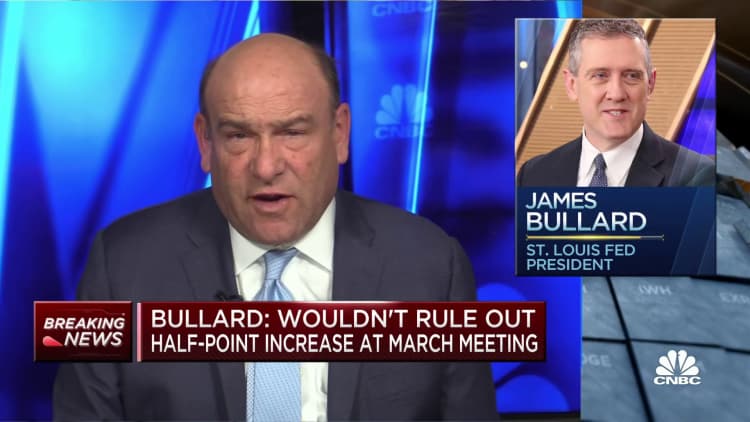[ad_1]
James Bullard, president and chief executive officer of the Federal Reserve Bank of St. Louis, delivers a speech in London, U.K., on Tuesday, Oct. 15, 2019.
Luke MacGregor | Bloomberg | Getty Images
This report is from today’s CNBC Daily Open, our new, international markets newsletter. CNBC Daily Open brings investors up to speed on everything they need to know, no matter where they are. Like what you see? You can subscribe here.
U.S. stocks are cowed by a persistently hot economy — and hawkish rhetoric from the Fed.
What you need to know today
- The U.S. producer price index, which measures inflation at the wholesale level, rose 0.7% in January. It was the biggest increase since June, and 0.3 percentage points higher than economists had expected.
- China Renaissance, an investment bank that has advised mergers between major Chinese tech firms, is unable to contact its CEO Bao Fan. Chinese financial news outlet Caixin pointed out that Cong Lin, former chairman of the bank’s subsidiary, is under investigation.
- Tesla is recalling 362,758 vehicles equipped with its experimental driver-assistant software. The company warned that the software, known as Full Self-Driving Beta, may cause vehicles to crash.
- PRO Crypto is making a comeback in 2023, according to Bernstein analyst Gautam Chhugani. Investors may be viewing recent regulatory actions in the U.S. as less severe than they had expected.
The bottom line
Looking at the January figures, the U.S. economy is firing on all cylinders. A quick recap: The lowest unemployment rate in 53 years. A rebound in consumer spending despite higher prices. And overnight, we found out that the producer price index rose the most in eight months. This almost bizarrely strong economy implies that inflation — while still falling — remains uncomfortably high and sticky.

For a while, it seemed as if markets could live with that — and even embrace it as a new normal, in which economic growth can exist comfortably with inflation higher than 2%. With each hotter-than-expected inflation report, markets rose.
Until yesterday. Markets finally caved in. The Dow Jones Industrial Average fell 1.26%, the S&P 500 lost 1.38% and the Nasdaq Composite dropped 1.78%. “It shouldn’t be a surprise to see the market take a breather as hopes of a dovish Fed in the coming months fade,” said Mike Loewengart, head of model portfolio construction at Morgan Stanley.
Indeed, it’s not just that Federal Reserve doves might be fluttering away. It’s that the hawks are swooping in. Markets had widely anticipated, and priced in, 25 basis-point interest rate hikes for the Fed’s next two meetings. Yesterday, that forecast was badly shaken.
St. Louis Federal President James Bullard said Thursday that he “was an advocate for a 50-basis-point hike and … argued that we should get to the level of rates the committee viewed as sufficiently restrictive as soon as we could.” Cleveland Fed President Loretta Mester echoed Bullard’s hawkishness, saying she wants higher rate increases. Neither Mester nor Bullard vote this year on the Federal Open Market Committee, but their sentiments could signal a Fed increasingly determined to strangle inflation.
Subscribe here to get this report sent directly to your inbox each morning before markets open.
[ad_2]
Source link
